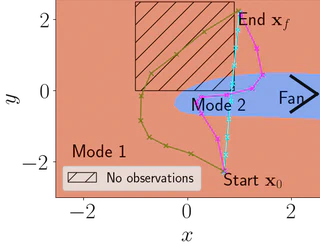Trajectory Optimisation in Learned Multimodal Dynamical Systems

This work presents a two-stage method to perform trajectory optimisation in multimodal dynamical systems with unknown nonlinear stochastic transition dynamics. The method finds trajectories that remain in a preferred dynamics mode where possible and in regions of the transition dynamics model that have been observed and can be predicted confidently.
The first stage leverages a mixture of Gaussian process experts method
(mogpe) written
in GPflow/TensorFlow
to learn a predictive dynamics model from historical data.
Importantly, this model learns a gating function that indicates the probability of being in a particular
dynamics mode at a given state location.
In the second stage,
this gating function acts as a coordinate map for a latent Riemannian manifold on which
geodesics are solutions to our trajectory optimisation problem.
Geodesics on this manifold satisfy a continuous-time second-order ODE.
A set of collocation constraints are derived that ensure trajectories are solutions to this ODE,
implicitly solving the trajectory optimisation problem.
The trajectory optimisation is implemented in JAX.